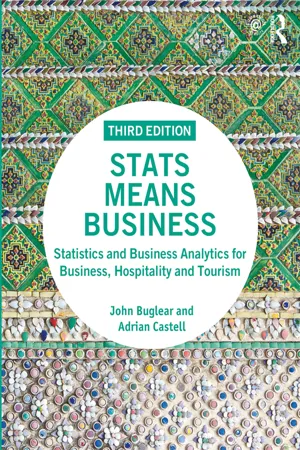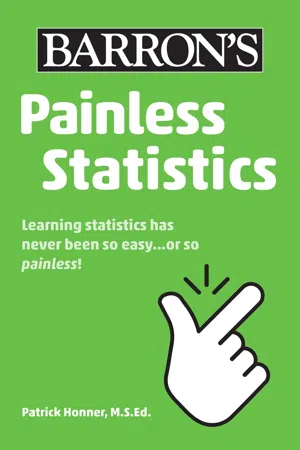Mathematics
Types of Data in Statistics
In statistics, data can be categorized into two main types: qualitative and quantitative. Qualitative data describes qualities or characteristics and is non-numeric, while quantitative data represents quantities and can be measured and expressed numerically. These types of data are fundamental in statistical analysis and play a crucial role in making inferences and drawing conclusions.
Written by Perlego with AI-assistance
Related key terms
11 Key excerpts on "Types of Data in Statistics"
- eBook - ePub
- John Buglear(Author)
- 2012(Publication Date)
- Routledge(Publisher)
There are many different diagrams and charts that can be used to do this, so it is important to know when to use them. Deciding which type of diagram to use from such a wide selection is not always straightforward, but picking the right one depends on the type of data you are dealing with. In the same way that a fork is an invaluable tool if you are eating spaghetti, but completely useless for consuming soup, a particular statistical diagram may be appropriate for some types of data and entirely inappropriate for others.2.1 Types of dataThe word data means a set of known facts. There are different types of data because there are different ways in which facts are gathered. Some data may exist because specific things have characteristics that have been categorized whereas other data may exist as a result of things being counted, or measured on some sort of scale.Example 2.1A restaurant is described in a review as ‘attracting a wealthy clientele’.To verify this we could use socio-economic definitions of class to categorize its customers, or we could count the number of homes owned by each customer, or we could measure the amount of land owned by each customer.The first important distinction to make is between qualitative data and quantitative data. Qualitative data consists of categories or types of a characteristic or attribute. In Example 2.1 the socioeconomic definitions, social class A, B, C1 and so on, would be qualitative data, whereas the numbers of houses or amount of income would be quantitative data. Any data that is based on characteristics or attributes is qualitative. Data that is based on counting or measuring is quantitative data.The second important distinction to make is between the two different types of quantitative data: discrete and continuous. Discrete data is quantitative data that can take only a limited number of values because it is produced by counting in distinct or ‘discrete’ steps, or measuring against a scale made up of distinct steps.There are three types of discrete data that you may have to deal with:1 Data that can only take certain values because other values simply cannot occur, for example the number of children in parties of tourists. There could be 12 children in one group and 7 in another, but no group could have 9.3 children because there is no such thing as 0.3 of a child. - eBook - ePub
- Clive Opie(Author)
- 2004(Publication Date)
- SAGE Publications Ltd(Publisher)
9 which look specifically at the analysis of qualitative data through the use of two computer software packages – NUD•IST and ATLAS.ti – from Scolari (2002).PART 1: QUANTITATIVE DATA
Types of quantitative data
Our starting point has to be an understanding of types of quantitative data and what you can do with it. Although a number of texts refer to four types of quantitative data – nominal, ordinal, interval and ratio (Sapsford and Jupp, 1996) – it is easier to reduce this to three where interval and ratio data are considered together. The fine distinction between interval and ratio data is discussed elsewhere (Moore, 1997) and for our purposes linking them will not be problematic. These types of data and a brief explanation of their differences are shown in Table 7.1 .It is not always easy to reconcile what type of data you have but it is crucial you know this, as this in turn will determine what you can do with it. For example nominal data only provides non-parametric statistics, which can measure mode frequencies and the use of the statistic analysis Chi square (χ2 ). Ordinal data offers other non-parametric statistical analysis such as Spearman Rank Order and Kruskal-Wallis tests. It is only with interval and ratio data that you can undertake parametric statistics such as ANOVA and t-tests. You may be getting worried at the terms in this paragraph but they are all explained in the Glossary (see Chapter 10 ), and keep in mind that for MEd work in many instances you may well not need to undertake anything more complicated than frequency counts, which are an aspect of descriptive statistics.Table 7.1 Types of quantitative dataType of dataFunctionNominal This simply puts data into categories – nothing more and nothing less. For example different types of ethnic groups. Ordinal This indicates that the order of numbers is meaningful but they have no arithmetical significance, i.e. the intervals have no constant difference between them. For example, grading students by exam marks. The order is meaningful but you cannot say that someone scoring 80% is twice as good as someone who scores 40% or that the difference between 45% and 55% is the same as that between 60% and 70%. - eBook - ePub
Stats Means Business
Statistics and Business Analytics for Business, Hospitality and Tourism
- John Buglear(Author)
- 2019(Publication Date)
- Routledge(Publisher)
informs. You will be bringing meaning to the apparently meaningless.There are different diagrams and charts that you can use to do this, so it is important to know when to use them. Deciding which type of diagram to use from such a wide selection is not always straightforward, but picking the right one depends on the type of data you have. In the same way that a fork is an invaluable tool for eating spaghetti but completely useless for consuming soup, a particular statistical diagram may be appropriate for some types of data and entirely inappropriate for others.2.2 Types of data
The word data means a set of known facts. There are different types of data because there are different ways in which facts are gathered. Some data arise because specific things have characteristics that have been categorised, whereas other data come from things being counted or measured on some sort of scale.Example 2.1
Holders of a certain type of credit card are described as ‘wealthy’. To verify this, we could use socio-economic definitions of class to categorise each cardholder, we could count the number of homes owned by each cardholder or we could measure the income of each cardholder.The first important distinction to make is between qualitative data and quantitative data. Qualitative data consist of categories or types of a characteristic or attribute. These categories form the basis of the analysis of qualitative data. In Example 2.1 the socio-economic definitions (social classes A, B, C1 and so on) would be qualitative data, whereas the numbers of houses or amount of income would be quantitative data. Quantitative data are produced by counting or measuring. The numerical scale used to produce the figures forms the basis of the analysis of quantitative data.The second important distinction to make is between the two different types of quantitative data: discrete and continuous - eBook - ePub
- Tom Lissauer, Will Carroll, Tom Lissauer, Will Carroll(Authors)
- 2016(Publication Date)
- Elsevier(Publisher)
Qualitative data, by comparison, is descriptive and usually represents an expression of thoughts, feelings or experiences. There are resources available which detail appropriate methodologies for analysing qualitative data, but this will not be covered in this chapter.Quantitative data (also referred to as variables , i.e. a characteristic, number or quantity that differs between individuals or items) can be numeric , in which a number is recorded, or categorical (Fig. 38.1 ).Numeric data, in which a number is recorded, can be further subdivided into discrete or continuous datasets:Fig. 38.1 Types of quantitative data.Categorical data can be:• Discrete data can only be expressed in whole numbers; for example, number of children per family or number of episodes of severe asthma per year.• Continuous data , on the other hand, can take any value in a given range. For example, height, weight or age.• Binary data – in which there are only two categories; for example, alive/dead or a yes/no response.• Ordinal data – which is in groups that can be ordered; for example, social class 1–5 or grades of bowel cancer.• Nominal data – constitutes a number of groups with no order/hierarchy; for example, blood group or marital status.Displaying data
The best method for displaying data depends on the type of data and the number of variables and datapoints. A good pictorial presentation of data can be an extremely effective and efficient means of communication. It is also crucial to plot the data:• - eBook - ePub
- Patrick Honner(Author)
- 2022(Publication Date)
- Barrons Educational Services(Publisher)
Chapter 2 Data and RepresentationsStatistics is all about working with data, so you need to understand what data is. In this chapter, you’ll learn about different types of data and how to work with them. You’ll also learn about different ways of visualizing and representing data, which can help make analyzing and interpreting data painless.Types of DataData is information. The information can be about people, places, or processes, and it can come in the form of numbers or characteristics. All these different kinds of information are different types of data, and there are two important types of data you should be familiar with.Quantitative Data vs. Categorical DataThe data sets that were discussed in Chapter 1 were commute times, so the data came in the form of numbers. That is an example of quantitative data. Quantitative data is numeric information, like times, heights, prices, and test scores. This is a very common type of data in the application of statistics, and most of the examples you’ll see in this book involve quantitative data.However, data isn’t always quantitative. Suppose that, instead of recording how long their daily commute is, you asked people the method they use to commute to work each day. In this scenario, the information you’re looking for isn’t a number; it’s a mode of transportation (by car, by bus, by bike, and so on). This is an example of categorical data. Categorical data indicates the category, or categories, individuals belong to.Even though categorical data isn’t necessarily quantitative in nature, you can still use numbers to help understand it. For example, you might represent this categorical data in a table.Commute Method Percentage Car 32% Bus/Train 40% Bike 16% Walk 12% A table is a way to represent the information and is helpful in understanding and interpreting the data. The table above, for example, shows what percentage of individuals fall into each category. You’ll learn other ways to represent categorical data later in this chapter. - eBook - ePub
Medical Statistics
A Textbook for the Health Sciences
- Stephen J. Walters, Michael J. Campbell, David Machin(Authors)
- 2020(Publication Date)
- Wiley-Blackwell(Publisher)
2 Displaying and Summarising Data- 2.1 Types of Data
- 2.2 Summarising Categorical Data
- 2.3 Displaying Categorical Data
- 2.4 Summarising Continuous Data
- 2.5 Displaying Continuous Data
- 2.6 Within-Subject Variability
- 2.7 Presentation
- 2.8 Points When Reading the Literature
- 2.9 Technical Details
- 2.10 Exercises
Summary
This chapter describes different types of data that the reader is likely to encounter. It illustrates methods of summarising and displaying categorical data (bar charts, pie chart). It describes the different ways of summarising continuous data by measures of location or central tendency (mean, median, mode) and measures of spread or variability (range, variance, standard deviation, inter‐quartile range). It also illustrates how to display continuous data (dot‐plots, histograms, box‐and‐whisker plots).2.1 Types of Data
Just as a farmer gathers and processes a crop, a statistician gathers and processes data. For this reason, the logo for the UK Royal Statistical Society is a sheaf of wheat. Like any farmer who knows instinctively the difference between oats, barley, and wheat, a statistician becomes an expert at discerning different types of data. Sections of this book will refer to different data types and so we start by considering these distinctions. Figure 2.1 shows a basic summary of types, although some data do not fit neatly into these categories.Broad classification of the different types of data with examples.Figure 2.1Example from the Literature – Salicylic Acid Plasters for Treatment of Foot Corns
Table 2.1 gives a typical table reporting baseline characteristics of a set of patients entered into a randomised controlled trial that investigated the effectiveness of salicylic acid plasters compared with usual scalpel debridement for treatment of foot corns (Farndon et al. 2013 - eBook - ePub
A Panorama of Statistics
Perspectives, Puzzles and Paradoxes in Statistics
- Eric Sowey, Peter Petocz(Authors)
- 2017(Publication Date)
- Wiley(Publisher)
states.The quantitative/qualitative distinction is a very basic one; there are more elaborate ways of classifying variables. One such classification scheme was devised in 1946 by the US psychologist Stanley Stevens. His scheme puts variables into four classes: categorical (also called ‘nominal’), ordinal, interval and ratio.Categorical data are associated with a fixed set of non‐overlapping categories. Examples of a categorical variable are city of birth and marital status. Ordinal data (as the name suggests) are assigned a place in an ordered scale according to some criterion. Examples of an ordinal variable are military rank and a composer’s opus numbers (that record the order of composition of musical works, without reference to the time elapsed between their dates of publication). Interval data are numerical values that have a precise position on a continuous scale, with an arbitrary zero. They are a step up from ordinal data, in that one can say how much further along a scale one item is than another. Examples of an interval variable are longitude and temperature in degrees Celsius. Finally, ratio data are numerical values that have a precise position on a continuous scale with an absolute zero. Examples of ratio variables are length and weight.It should be clear from these definitions that interval and ratio variables are quantitative variables. Further, a categorical variable is clearly a qualitative variable. But what can we say about an ordinal variable? Is it quantitative or qualitative? This is a perplexing question, for some ordinal data appear to be quantitative (opus numbers, in our example), while others seem to be qualitative (e.g. military rank).This issue has caused a great deal of controversy in statistics, especially in regard to psychological data. Psychologists routinely collect ordinal data in their experiments, and are accustomed to assigning numerical ranks to their observations before analysing them. Think, for instance, about the following behavioural question and its numerically ranked responses: Do you smoke? (often 1, sometimes 2, rarely 3, never 4). - eBook - ePub
- Garry Anderson, Nancy Arsenault(Authors)
- 2005(Publication Date)
- Routledge(Publisher)
As the description gets more sophisticated, the researcher groups the data and presents it in tables and figures. The use of descriptive statistics is merely a convenient way of description. Data are reported in tables organized to give a suitable overall picture at a glance. These simplify the description and lend meaning to data which in raw form is hard to interpret. The most complete and useful descriptions present data in matrices or frameworks (see Chapter 6) which convey data characteristics for sub-groups or different cells in the framework. Often summary statistics such as means, standard deviations, measures of normalcy and so forth are also provided. Basic Statistical Concepts Types of Variables Qualitative description ranges from brief narrative passages to whole books devoted to the description of a phenomena or setting. Contemporary researchers are also using modern technology to facilitate such description. One of my doctoral students is considering the use of CD-ROM technology keyed to the text in his dissertation and enabling the reader to pull up an actual interview or view a meeting in progress. In their most complete form qualitative descriptions lead to interpretations which are the basis of ethnography as a method. In general, most studies include such description to some degree, though it may be a minor part of the whole. Specific Types of Descriptive Methods There are several uses of descriptive methods which are sufficiently common to be methods in their own right. Content Analysis Content analysis is applied to the analysis of data in documents and refers to the systematic description of the contents of documents - eBook - ePub
Statistical Methods for Organizational Research
Theory and Practice
- Chris Dewberry(Author)
- 2004(Publication Date)
- Routledge(Publisher)
Very often the intention is to capture the essence of the numbers, to summarize them in such a way as to render them as easy as possible to understand and digest. The second area, inferential statistics, is concerned with analysing numbers and drawing conclusions from them. Basically, this involves collecting a relatively small set of numbers (for example, those referring to the job commitment of 30 employees in a car manufacturing plant) and using them to make guesses about a larger set of numbers that the researcher is interested in (for example, the job commitment of everyone in the car manufacturing plant). Let’s begin by examining fundamental elements of descriptive statistics. The numbers collected in quantitative research are referred to as data. So if you collect the ages of five people: – Ruth: 35 years – John: 42 years – Julie: 57 years – Andy: 27 years – Jill: 33 years the ages of these five people constitute your data. Each particular number, such as the 35 years of Ruth, is referred to as a data point. So here you have one set of data and five data points: 35, 42, 57, 27 and 33. Data can be collected from anything – rivers, shirts, carpets, clocks, mice – anything at all can provide us with numerical information. In organizational research, data are usually collected about individuals working in organizations (e.g. the appraisal ratings of 20 different employees), about collections of people (e.g. the number of units sold by 20 different sales teams), about organizations themselves (e.g. the share price of 100 companies), and about their products (e.g. the number of defective radios produced by an electrical manufacturer). In this book, for the sake of consistency, the focus is on individuals working in organizations. In other words, the unit of analysis is people, and it is assumed to be individual people that data are collected on - eBook - ePub
Quantitative Techniques in Business, Management and Finance
A Case-Study Approach
- Umeshkumar Dubey, D P Kothari, G K Awari(Authors)
- 2016(Publication Date)
- Chapman and Hall/CRC(Publisher)
When the data is classified according to some attributes (distinct categories) which are not capable of measurement, this is known as qualitative classification. In a simple (or dichotomous) classification, an attribute is divided into two classes, one possessing the attribute and the other not possessing it. For example, we may classify population on the basis of employment, that is the employed and unemployed. Similarly, we can have manifold classifications when an attribute is divided to form several classes. For example, the attribute ‘education’ can have different classes, such as primary, middle, higher secondary and university.2.4.1.4 Quantitative ClassificationWhen the data is classified according to some characteristics that can be measured, this is called quantitative classification. For example, the employees of a company may be classified according to their monthly salaries. Since quantitative data is characterised by different numerical values, the data represents the values of a variable. Quantitative data may be further classified into one or two types: discrete or continuous. The term discrete data refers to quantitative data that is limited to certain numerical values of a variable, for example the number of employees in an organisation or the number of machines in a factory.2.5 Data Collection
2.5.1 Population
This is the entire collection of entities that a manager is trying to study.2.5.2 Sample
This is a fraction of the population that represents the entire population in its characteristics proportionately. For example, when a magazine conducts an opinion poll among 1000 individuals from all over India, with a view to know the general opinion of Indians towards politicians, then all Indians is the target population and 1000 individuals represent the population and is referred to as the sample.In another example, to estimate the potential market for a new innovation, managers in a research department may study 1000 consumers in a particular territory. The managers make sure that this sample contains the consumers belonging to all cross sections (income, religion, education and locality) of the society. - eBook - ePub
- Michel Jambu(Author)
- 1991(Publication Date)
- Academic Press(Publisher)
Chapter 31-D Statistical Data Analysis
Michel Jambu1 Introduction
A statistical series resulting from numerous observations needs to be summarized in a small set of numbers so that one can compare several series and understand them easily. A summary can be numerical or graphical:numerical: each numerical summary highlights a specific feature of a series. It is affected by the point of view of the statistician.graphical: graphics indicate more than numerical summaries, from which they are generally derived.Most of the time, graphical and numerical summaries are used simultaneously, and they are both studied for the following types of variables: quantitative, qualitative, multiple form qualitative, and chronological.2 1-D Analysis of a Quantitative Variable
As an example, consider the series from the data set of prices of cars. (cf . Appendix 2 , §1). How can one summarize this series? A statistician can study it from three points of view:1.What are the most representative values of the data set in terms of local concentration ?2.What are the most representative values of the data set in terms of dispersion ?3.We study these three points of view successively.What are the most representative values of the data set in terms of shape ?2.1 Measures of Central Tendency
Our aim is to characterize a statistical series by a single number (a type-value), representing the order of magnitude of the whole set of numbers, so that we may compare two series by comparing their type-values. The type-value should satisfy the conditions given by Yule (1950) :1. The type-value must be defined independently of the observer, and independently of the conditions under which the observations were taken.2. The type-value must depend on all the values of the series. In particular, values considered as exceptional or irrelevant must be integrated when computing the type-value.
Index pages curate the most relevant extracts from our library of academic textbooks. They’ve been created using an in-house natural language model (NLM), each adding context and meaning to key research topics.










